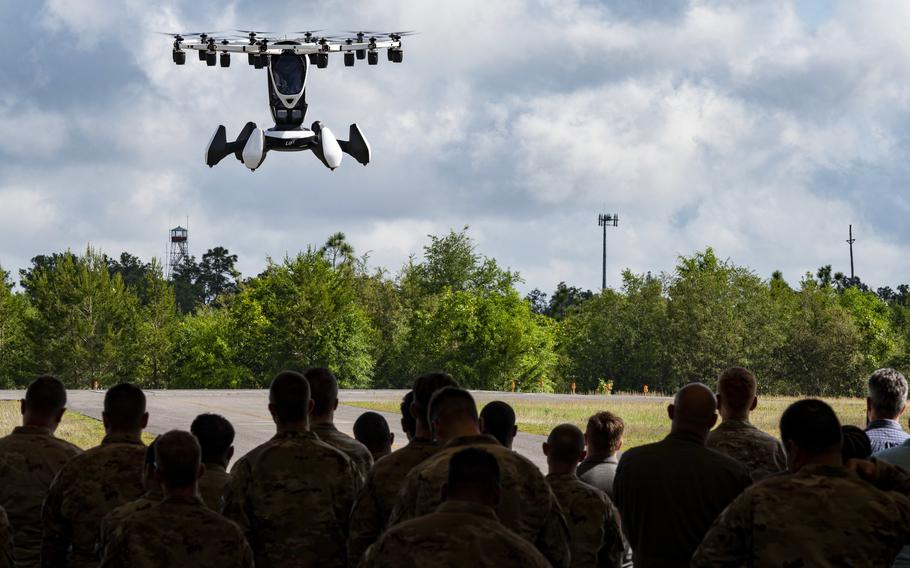
Lift Aircraft’s Hexa aircraft, an Air Force Agility Prime project vehicle, demonstrates its abilities to U.S. airmen and civilian staffers at Hurlburt Field, Fla., May 3, 2022. Lawmakers are pushing for the rapid adoption of electric and hybrid aviation technologies in the military, aiming to enhance efficiency and reduce the carbon footprint of defense operations. (Taylor Crul/U.S. Air Force)
A U.S. military with “flying cars” may soon no longer be the stuff of science fiction, as House legislators seek to push the Defense Department to speed up integration of commercial electric and hybrid technology into aircraft.
A House subcommittee’s section of the proposed 2025 National Defense Authorization Act directs the Air Force and the Pentagon to set up a working group made up of top-ranking defense officials to spur applications of a program called Agility Prime.
The 4-year-old Air Force program explores the potential military applications for electric aircraft through industry partnerships.
It involves testing of electric vertical takeoff and landing vehicles, dubbed “flying cars” or “flying taxis,” with an eye toward using them for such tasks as search-and-rescue and carrying passengers or cargo.
The aircraft “can move people and things around in a more efficient and environmentally friendly way,” according to an Air Force Research Lab news bulletin.
Agility Prime — which is run by the Air Force’s innovation arm, known as AFWERX — has contracts with a spate of manufacturers producing electric aircraft for the program.
Among AFWERX’s repertoire are aircraft from California-based Joby Aviation and at least one Alia plane from Beta Technologies that was delivered in October to Eglin Air Force Base in Florida to begin testing.
In November, the Alia completed its first test flight. It flew 68 nautical miles round trip, making a pit stop to recharge its batteries at a DOD charging station, Air Force officials said.
The Pentagon sees all-electric manned aircraft as a way to reduce its carbon footprint.
If the new proposal becomes law, the working group will have to be set up within six months. It would be run by the Air Force secretary and would include the Army and Navy secretaries, the chairman of the Joint Chiefs of Staff, and representatives of U.S. Special Operations and Transportation commands, according to the proposal.
The group would be tasked with identifying military applications for advanced aviation technologies and figuring out how to transition those from research and development to operational use across the services.
Those capabilities include hybrid and electric vertical takeoff and landing aircraft, advanced air mobility platforms, and autonomous flight, test and evaluation software, according to the proposal by the subcommittee of the House Armed Services Committee.
The Air Force secretary would have to submit reports on the working group’s preliminary progress to the House and Senate defense committees by the end of September 2025, followed by two more annual reports.